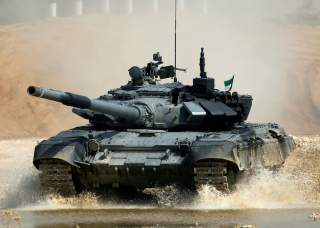Russia Has Awesome Tanks, but Which Is the Finest?
Stack them up.
Key point: Moscow has a wide assortment of war machines. Several of its tanks are among the best, and there is much debate about which outclasses them all.
Which tank does Russia love most?
Russia operates a variety of tanks, including the T-72, T-80 and T-90. In an interview with the military newspaper Red Star [English translation here], Major General Sergey Kisel, commander of the First Guards Tank Army, offered his assessment of the various tanks operated by his unit.
Kisel should know. The First Guard Tanks Army is arguably the most famous Russian armored formation, spearheading the Red Army’s drive to Berlin in 1945. Disbanded in 1998, it was reactivated in 2016 in western Russia, where it would in the forefront of a conflict with NATO.
The workhorse of the First Guards Tank Army is the T-72B3, which Kisel described as “a reliable tank.” An upgraded version of the venerable Cold War T-72, the fifty-ton T-72B3 has better armor, thermal imaging sensors and improved fire control. “Our main battle tank, the T-72B3, possesses sufficient specifications to detect and destroy any enemy on the battlefield,” said Kisel. “Their electronics make it possible significantly to enhance the accuracy of hitting targets.”
“It differs from foreign models in that it is far smaller - which makes it less vulnerable,” he added. “At the same time, it has a faster rate of fire and possesses good marching capabilities.”
In contrast, the forty-six-ton T-80 is the racehorse built for mobility. As with the U.S. M-1 Abrams, the gas-turbine engine on the T-80 has been panned for being a fuel guzzler. But the T-80BV and T-80U “have gotten a good name for themselves,” says Kisel, who notes that the T-80 was originally developed as a breakthrough tank and can reach a speed of 90 kilometers per hour [56 miles per hour].”
“The armament system on the T-80BV is the same as on the T-72B3 and the T-90,” he adds. “A special feature of the T-80BV is that this tank is capable of operating at low temperatures. Its gas turbine engine, whose design does not provide for a cooling liquid, is undemanding in frosts. The T-80BV and the T-80U are distinguished by unique marching specifications and are capable of covering large distances in a short space of time.
Kisel did not have as much to say about the T-90, other than that the 1st Guards Tank Army has “subunits with T-90 tanks that differ fundamentally from other vehicles in terms of the degree of protection for the crew, the long firing range, and more powerful engine.” Essentially a heavily modernized T-72, the fifty-one-ton T-90 is equipped with the Shtora defensive countermeasures system and explosive reactive armor to deflect anti-tank weapons. Its 125-millimeter 2A46M smoothbore cannon can fire both conventional shells and AT-11 Sniper anti-tank guided missiles.
What’s also interesting are Kisel’s observations on tank warfare. Tanks may differ across nations, but not the challenges of modern armored warfare. When asked by Red Star about the impact of technologies such as drones, robot vehicles and computerized systems, Kisel’s observation could have been uttered by an American or Israeli commander.
“The introduction of increasingly complex technical systems requires constant raising of the servicemen’s level of knowledge and combat training. Thus, a tankman is obliged to have thorough knowledge of hardware, ballistics, and the special features of modern combined-arms combat, which has become exponentially more complex in recent decades. Today demands are made of a tank commander that at one time were made of commanders of large subunits.”
Michael Peck is a contributing writer for the National Interest. He can be found on Twitter and Facebook. This first appeared in 2019.
Image: Reuters

